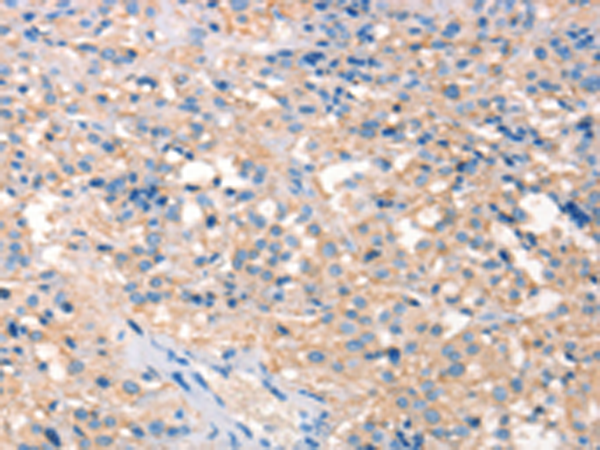

| WB | 咨询技术 | Human,Mouse,Rat |
| IF | 1/20 | Human,Mouse,Rat |
| IHC | 1/50-1/100 | Human,Mouse,Rat |
| ICC | 1/50-1/200 | Human,Mouse,Rat |
| FCM | 咨询技术 | Human,Mouse,Rat |
| Elisa | 咨询技术 | Human,Mouse,Rat |
| Aliases | ARTS; DFN2; PRSI; CMTX5; DFNX1; PRS-I; PPRibP/PRSII/PRPS1; PRPS3; PRPSL; PRS-III |
| WB Predicted band size | 35 kDa |
| Host/Isotype | Rabbit IgG |
| Antibody Type | Primary antibody |
| Storage | Store at 4°C short term. Aliquot and store at -20°C long term. Avoid freeze/thaw cycles. |
| Species Reactivity | Human, Mouse |
| Immunogen | Synthetic peptide of human PRPS1/2/1L1 |
| Formulation | Purified antibody in PBS with 0.05% sodium azide and 50% glycerol. |
+ +
以下是关于BAD蛋白抗体的模拟参考文献示例(注:以下内容为示例,建议通过学术数据库查询真实文献):
---
1. **文献名称**:*"A Monoclonal Antibody Specific for Phosphorylated BAD Reveals Apoptosis Regulation by Survival Signaling Pathways"*
**作者**:Chen, Y., et al.
**摘要**:本研究开发了一种特异性识别BAD蛋白Ser-136磷酸化位点的单克隆抗体,验证了其在流式细胞术和免疫印迹中的灵敏度。结果表明,生长因子通过激活AKT通路促进BAD磷酸化,从而抑制其促凋亡活性,揭示了BAD在细胞存活中的动态调控机制。
2. **文献名称**:*"BAD Protein Localization in Neuronal Apoptosis: Insights from Immunohistochemical Staining"*
**作者**:Miyashita, T., & Reed, J.C.
**摘要**:通过优化BAD抗体的免疫组化条件,作者发现BAD在阿尔茨海默病模型小鼠的神经元线粒体中异常聚集。研究证实,BAD与Bcl-XL的相互作用失衡可能导致神经退行性病变,为靶向BAD的神经保护策略提供了依据。
3. **文献名称**:*"Validation of a Novel BAD Antibody Panel for Quantifying Isoform-Specific Expression in Cancer Tissues"*
**作者**:Gupta, S., et al.
**摘要**:该研究比较了多种市售BAD抗体的特异性,开发了一套用于区分BAD长/短亚型的抗体组合。通过分析结直肠癌样本,发现短亚型高表达与患者生存率下降显著相关,提示其作为预后标志物的潜力。
4. **文献名称**:*"Cross-Reactivity Challenges in BAD Antibody Development: Lessons from Structural Epitope Mapping"*
**作者**:Wang, H., et al.
**摘要**:探讨了BAD抗体与BCL-2家族其他成员(如BIM)发生交叉反应的原因。通过表位定位实验,揭示了抗体设计中需避免的保守区域,为开发高特异性凋亡相关抗体提供了技术指导。
---
**建议**:可通过PubMed、Google Scholar等平台,以关键词“BAD antibody phosphorylation”“BAD apoptosis assay”或“BCL-2 family antibody validation”检索最新文献。实际研究中需严格验证抗体验证数据(如KO细胞验证、肽竞争实验等)。
Bad antibodies refer to antibodies targeting the Bcl-2-associated death promoter (Bad) protein, a pro-apoptotic member of the Bcl-2 family critical in regulating mitochondrial apoptosis. Discovered in the late 1990s, Bad promotes cell death by binding to anti-apoptotic proteins like Bcl-2 or Bcl-xL, displacing pro-apoptotic effectors (e.g., Bax/Bak) to trigger cytochrome c release and caspase activation. Its activity is tightly controlled by phosphorylation; survival signals (e.g., growth factors) activate kinases like Akt or PKA to phosphorylate Bad, enabling its sequestration by 14-3-3 proteins and blocking apoptosis. Dysregulation of Bad is implicated in cancer, neurodegeneration, and autoimmune diseases.
Bad-specific antibodies are essential tools in research, enabling detection of Bad expression, post-translational modifications (e.g., phosphorylation at Ser136 or Ser112), and subcellular localization via techniques like Western blot, immunofluorescence, or flow cytometry. These antibodies help elucidate Bad’s role in apoptotic pathways, drug resistance, and disease mechanisms. However, variability in antibody specificity (e.g., distinguishing phosphorylated vs. unmodified Bad) requires rigorous validation to avoid experimental artifacts. Despite challenges, Bad antibodies remain pivotal in studying cell death regulation and developing therapies targeting apoptosis-related disorders.
×